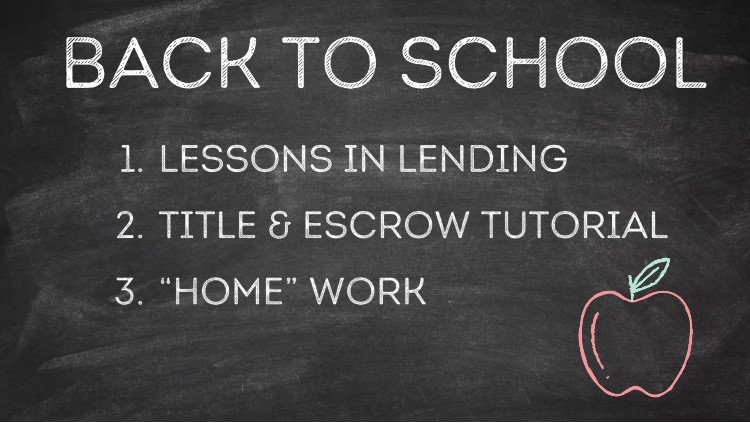What a great time of year to get back into a schedule! Whether that means kids in school, your work team back from vacations or just feeling the change of season to refresh your health habits! A part of me loves the lazy days of summer and rolling through the week without a clearly defined schedule but there’s something invigorating about getting into a routine again!
To celebrate this season of back to school – Get ready, school is session! I’m putting on my teacher hat to bring you- Lessons in Lending, a Title & Escrow Tutorial and just a little bit of “home”work just right for this season of the year.
 Lessons in Lending
Lessons in Lending
When you’re in the midst of buying or selling a home, the lingo can be overwhelming and perhaps confusing. Our first assignment is to prepare you for the terms you might encounter while shopping for a mortgage lender or as you jump into the process. And remember finding an amazing lender and getting pre-approved is the very second step of the buying process (the 1st step is chatting with me to create your plan together and sharing with you an exceptional list of highly qualified lenders to interview!)
Mortgage: This is the loan used to buy a home. You repay the mortgage over a predetermined period of time, typically 15 or 30 years. The lender will hold the deed until that time. The property secures a mortgage loan, which means your lender can repossess it by way of foreclosure if you default.
Credit report: Mortgage lenders will review one or more of your credit reports, which keep a record of your account balances, total debt, age of your credit accounts, payment history and other information. Credit reports give lenders a sense of how well you’ve historically managed your accounts, which helps them predict how likely you would be to default on a home loan.
Down payment: This is the money you contribute upfront toward your home purchase. While a 20% down payment was once the norm, it’s possible to buy a home with much less.
Origination fee: The origination fee is an upfront charge a mortgage lender may throw in to pay for certain costs related to your home loan. It could cover everything from preparing and underwriting the loan to processing your application.
Closing costs: typically include your origination fee, along with fees associated with your home inspection, appraisal, application, title insurance, credit check and more. The final amount is usually equal to 2% to 5% of the home sale price.
Fannie Mae and Freddie Mac: These federally backed mortgage companies are major buyers and sellers of mortgage loans. Fannie Mae and Freddie Mac buy mortgages from banks, then group them together before selling them to investors. This enables banks to lend more money to homebuyers. Loans that adhere to Fannie Mae and Freddie Mac lending standards are called conforming loans.
Debt-to-income ratio: Lenders want to see how your debt obligations compare with your gross (pretax) monthly income. This is called your debt-to-income ratio (DTI). A lower DTI is preferred by lenders because it shows that you have room in your budget for a new mortgage payment
Loan-to-value ratio: This number represents your home loan amount as it relates to the home’s current market value. Loan-to-value ratio (LTV) is determined by dividing the amount owed on the loan by the appraised home value, then multiplying that number by 100. To get a conventional mortgage, you’ll want to shoot for an LTV of 80% or less.
 Title and Escrow Tutorial
Title and Escrow Tutorial
Perhaps a more mysterious but vitally important aspect of homeownership and buying/selling real estate is Title and Escrow. This duo of terms is often thrown around as a unit, but the different identities of each component require explanation and understanding. Title is a document that shows legal ownership to a property or asset. A title might show ownership of property rights of an individual or business. Titles can be obtained by purchase or inherited as an estate. Escrow is an impartial 3rd party process in which documents and funds are deposited by buyers, sellers and lenders to facilitate the closing for a real estate transaction. Title and escrow work in unison to complete the transaction of real property moving from one owner to the next. Here’s a selection of other terms to know as you’re maneuvering the process of a real estate transaction.
Appraisal – a report from an independent third party detailing the estimated value of real estate.
Closing disclosure – A 5 page form that provides final details about the mortgage loan the buyer has selected. In includes the loan terms, projected monthly payments, and how much will be paid in fees and other costs to acquire a mortgage. It is given three days before closing.
Deed – a document through which a conveyance of property is effected. This is the document the seller will sign.
Easement – the right to use all or part of the land owned by another for a specific purpose. An easement may, for example entitle its holder to install and maintain sewer or utility lines.
Legal Description – the legal way to describe a property based on the location as recorded in the official plat maps of county in which its located.
Lien – a monetary charge imposed on a property, usually arising from some debt or obligation.
Recording – the noting in public office of the details of a legal document (such as deed or mortgage) affecting the title to real estate. When such an instrument is properly recorded, it is considered to be a matter of public record. Legally, that means that all subsequent purchasers are deemed to have constructive knowledge of that information.
Title Commitment – Also called the title report, this is a document issued by a title insurance company that contains the conditions under which a policy of title insurance will be issued.
Title Insurance Policy – A contract of title insurance under which the insurer, in keeping with the terms of the policy, agrees to indemnify the insured against loss arising from claims against the insured’s interest in the property.
While having a familiarity and working understanding of these terms is important, knowing you have a great team of professionals supporting your goals and process is even more vital. Now that your head is swirling with lending and title terms, ready for a more hands on activity?!
As a homeowner, it often feels as if there’s an endless to do list to tackle! But, if you stay on season with the “home”work, the maintenance won’t add up to deferred maintenance costing you much more down the line. As we head into the Fall, it’s the perfect time to prepare your home to handle the harsh weather the winter brings. 
Fall Maintenance “Home”work :
- Clean, or possibly replace, your gutters. Before the rain really starts to fall, make sure all that water can flow freely to keep from sitting on your gutters, roof, siding or foundation.
- Check for drafts. Heat loss through windows is responsible for 25-30 percent of heating energy use, according to the U.S. Department of Energy. But it doesn’t have to be that way, because weatherstripping is simple and probably the most cost-effective way to keep heating costs down.
- Drain your outdoor faucets – before there’s any threat of freezing!
- Bring your outdoor furniture in. Yes, your furniture is outdoor furniture. No, that does not mean you should test the label by leaving it outside through hurricane-like weather and snowstorms.
- Fix any cracks in your driveway. I know, I know — this seems tedious and is one of those things where you’re like, “eh, it’ll be fine!” But, it could very easily not be fine. When water gets into cracks it freezes, expands, and can make the crack even bigger. And its always better for curb appeal!
- Change your filters. Another thing in your house that might be costing you more money than it should be. If your filters are clogged, it’s harder to keep your home at the temperature you want it to be which will increase your heating bills.
- Fertilize your lawn. You know what they say: The best offense is a good defense. If you want to keep your lawn looking great in the spring and summer, you need to prep it for the fall and winter.
- Test winter equipment. In the PNW we’re less likely to have snow blowers, and the like, but maybe invest in a snow shovel before the one week of snow arrives and they sell out at Home Depot. Same is true for investing in a generator which with stormy weather and power outages, might become your new best friend in the winter months.
- Change your batteries – you could get this handled before they inevitably start chirping at 3 am! Once a year you should be checking to make sure all smoke detectors and carbon monoxide devices are working.
Hope this Back to School season finds you thriving in new routines and inspired by learning! Don’t forget to do your homework! And this teacher is always ready to answer your questions, support your learning and rarely throwing a pop quiz in your direction!
~ Lindsay
 Facebook
Facebook
 X
X
 Pinterest
Pinterest
 Copy Link
Copy Link


